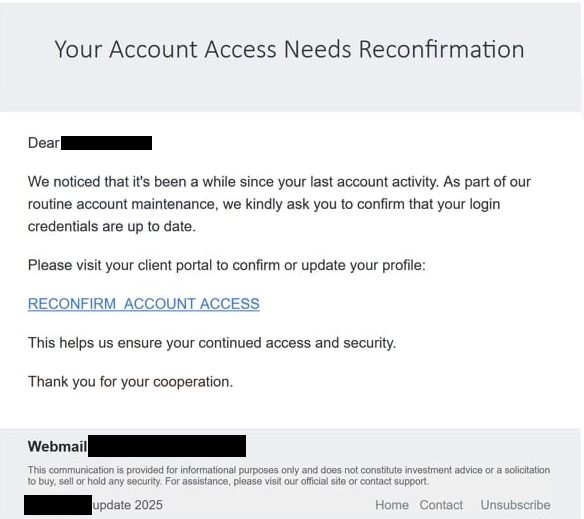Remove “Your Account Access Needs Reconfirmation” email
The “Your Account Access Needs Reconfirmation” email is a phishing scam designed to steal email login credentials. Disguised as a Webmail notification, it falsely claims that users need to confirm that their email login credentials are up to date. This is supposedly to ensure security. However, if users click the link in the email, they will be redirected to a phishing site that prompts them to log in to their email accounts. If users type in their password, it will be sent to the cybercriminals operating the phishing campaign.
The “Your Account Access Needs Reconfirmation” email is a typical phishing attempt that should be relatively easy for users to recognize as malicious. The email falsely claims that users must confirm that their email login information is up to date by clicking on the “Reconfirm account access” button. However, clicking this link redirects users to a phishing website designed to mimic the official Webmail login page. This phishing page prompts users to log in to their accounts, and any entered login credentials are sent directly to the cybercriminals behind the phishing campaign. These cybercriminals may exploit the stolen data themselves or sell it to others for various malicious purposes. But whatever the case may be, users would lose access to their email accounts.
It should be mentioned that email login credentials are especially valuable to cybercriminals because email accounts often contain years’ worth of sensitive information and are linked to multiple other accounts. Unauthorized access to an email account allows criminals to potentially hijack other connected accounts. If the email account holds confidential correspondence, the stolen information could be leveraged to blackmail the account owner.
The full text from the “Your Account Access Needs Reconfirmation” phishing email is below:
Subject: PLEASE RECONFIRM ACCESS
Your Account Access Needs Reconfirmation
Dear -,
We noticed that it’s been a while since your last account activity. As part of our routine account maintenance, we kindly ask you to confirm that your login credentials are up to date.
Please visit your client portal to confirm or update your profile:
RECONFIRM ACCOUNT ACCESS
This helps us ensure your continued access and security.
Thank you for your cooperation.
Webmail Support@ –
This communication is provided for informational purposes only and does not constitute investment advice or a solicitation to buy, sell or hold any security. For assistance, please visit our official site or contact support.
– update 2025 Home Contact Unsubscribe
How to recognize phishing emails
Phishing emails like the “Your Account Access Needs Reconfirmation” email are often not difficult to identify because of how generic they are. These generic campaigns typically target many users with identical emails, making them less personalized and more noticeably malicious. However, when a phishing attempt targets high-profile users or organizations, they tend to be more sophisticated and harder to detect. Fortunately, the majority of people mostly encounter the more common, generic phishing emails. Thus, as long as they know what to look for, they should be able to identify them fairly easily.
The “Your Account Access Needs Reconfirmation” email is immediately identifiable as a phishing attempt based on how it addresses the recipient. Instead of using the recipient’s name, it uses the email username. Legitimate emails from service providers always address users by the names they provided when creating their accounts. Malicious emails often use generic terms like User, Member, Customer, or the email username, or they may omit a greeting altogether, because they do not have access to more personal information, like a full name.
When you receive an unsolicited email, what you should do first is verify the sender’s email address. In some cases, the malicious nature of the address is immediately evident because the address will be very generic. However, cybercriminals may also disguise their email addresses to appear professional and legitimate. Doing a quick online search of the address can often help determine whether it’s legitimate. We should mention that malicious actors may also use spoofing techniques to make it seem like the emails were sent from users’ own accounts when that is not actually the case.
Users should pay attention to grammar and spelling mistakes, as legitimate emails are typically well-written, whereas low-effort phishing attempts often contain numerous mistakes, some more obvious than others. Even if an email appears polished, awkward phrasing can often be a red flag.
Lastly, links in unsolicited emails should never be clicked. If an email claims there is an issue with an account, it is safer to log in manually through a web browser to verify the issue rather than interacting with links in the email.
Remove “Your Account Access Needs Reconfirmation” phishing email
The “Your Account Access Needs Reconfirmation” email should be deleted, and its contents disregarded. If users have clicked on any links or provided their login credentials, they must immediately change their password, provided they still have access to their account. To prevent further compromise, it is essential to disconnect any linked accounts if access to the primary email is no longer possible.
Site Disclaimer
WiperSoft.com is not sponsored, affiliated, linked to or owned by malware developers or distributors that are referred to in this article. The article does NOT endorse or promote malicious programs. The intention behind it is to present useful information that will help users to detect and eliminate malware from their computer by using WiperSoft and/or the manual removal guide.
The article should only be used for educational purposes. If you follow the instructions provided in the article, you agree to be bound by this disclaimer. We do not guarantee that the article will aid you in completely removing the malware from your PC. Malicious programs are constantly developing, which is why it is not always easy or possible to clean the computer by using only the manual removal guide.

